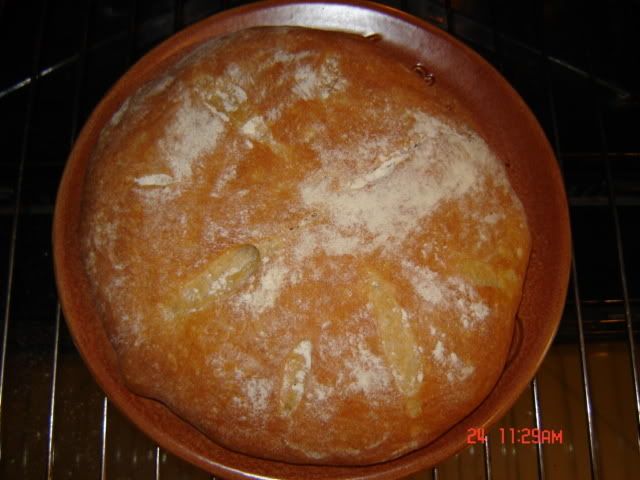Over the past few days, I have conducted 2 rustic bread experiments I will share with you. I have included every step for each experiment (let's call them RB 1 & RB 2), along with the formula and some pictures. I wanted to experiment with autolyze, long fermentation, folding, baking at different temperatures and different times). Hope this helps.
Le's get started; Here's the formula for both experiments:
Poolish:
120g Bread Flour, or ~ 1/2 cup
240g Water, or ~ 1 cup
1/4 tsp instant yeast
Dough:
530g Bread Flour, or ~ 4 cups
235g Water, or ~ 1 cup
1 tsp instant yeast
2 tsp salt
Hydration is 73%. I used additional flour for dusting, but tried as much as possible not to get too much flour worked in the dough. For RB 1, I used about 1/2 cup flour for dusting, and for RB 2, I was able to manage with about 1/3 cup.
For poolish, Both Breads used the same method: Mix water, yeast, flour. Cover and leave at room temperature for 12 hours.
Following the 12 hours, I did the following:
For RB 1: Mixed 530g flour with 235g water. Autolyzed 20 minutes, added poolish and yeast, mixed forever (I could not get the tough dough to break and be homogeneous with the liquidy poolish starter. Worked the dough with my hands, but it was still lumpy. After about 20 minutes, I gave up and added the salt; mixed a couple of minutes and turned the dough in a greased bowl and covered 90 minutes. Then turned out dough on floured surface, folded, covered for another 90 minutes. Again, I turned the dough on a floured surface and folded, covered for 90 minutes. And 2 more times, for a total of 4 folds every 90 minutes and about 8 hours total fermentation. I was letting the dough rise in the coolest room in the house (about 65F). The dough was extremely sticky and very hard to work with, even on floured surface. Here is the dough when I laid it out for the 1st fold:

Rising in the Studio (it happens to be the coolest room in the house. about 10F less than the rest of the house)

It did get easier with a few more folds. This is the dough after the 4th fold

For RB 2: Instead of only mixing the water and flour, I mixed the water, the flour, the poolish. Mixed for barely a couple fo minutes, and it came together, as opposed to 20 minutes in RB 1, added yeast, mixed 1 minute, added salt, mixed 2 minutes. This whole process took about 5 minutes, as opposed to about 30 minutes. Then I turned the dough in a greased blowl and covered for 90 minutes. This fermentation procedure is exactly the same for both breads. About 8 hours, with 4 folds at 90 minute intervals. Here's a picture of the dough right after Autolyze: Notice how the dough is much more homogenous and doesn't look as messy as RB 1.

Some points worth mentioning: the dough in RB 2 was much more coherent and homogeneous, less sticky then RB 1, and much easier to fold and work with. Also, I didn't need the same amount of dusting flour as I did for RB 1; I did not loose any dough in RB 2 due to stickiness as I did in RB 1. And the final weight of the baked breads were 835g for RB 1, and 907g for RB 2, so less of the dough was lost in RB 2 when folding. When stretching and folding the dough I kept my hands wet in both breads. I did not at anytime flour the surface of the dough when i was stretching and degassing it.
Shaping & Overnight proofing. After the 8 hours were up, it was time to shape. Let me mention that I don't have a proofer, or a basket, or a couche, or any of those helpers, so it wasn't easy to retain the desired shape.
For RB 1: Following the last rise, I turned the dough on a floured surface and shaped in a boule (what I hoped would have remained as such), put the dough on piece of parchement paper in a tray, cover with a damp towel and let rise for 3 1/2 hours. Then I placed in the fridge for 8 hours (overnight). The next morning, I preheated the oven to 250 C and removed the tray from the fridge and brought to room temperature for 1 hour. It was ready to bake. I must mention that while the dough did rise, it rose sideways, and became more of a flatter disk, which I attribute to high hydration.
For RB 2: I decided to get creative and restrain this dough from rising sideways, but before I discuss that, let me mention that I turned the dough out from the bowl, shaped in a boule, put it on piece of parchment paper in a tray, and let it rise only 2 1/2 hours, then I placed in the fridge to ferment for 12 hours as opposed to 8 hours for RB 1. The next morning I preheated the oven about 1 hour before baking, and removed the dough from the fridge 30 minutes before putting in the oven. Like I just mentioned, I had to restrain the dough from rising sideways, so i wrapped a floured linen towel around it to keep it from doing so, it worked great, but when I removed the towel to get the bread in the oven, the dough Flatened. Here's a look at my restraining system

Slashing & Baking: What a mess. Trying to slash a wet dough isn't working for me. It just does not work. It's never deep enough, always drags....... I even left the dough (RB 2) uncovered the last 10 minutes before putting in the oven so it would develpo a rougher structure and make it easier to work, but no can do. Still didn't come out right.
For Baking RB 1: Mist dough, transfer (with parchment paper) to hot baking stone, add water in a pan to create steam, and shut the door. 2 minutes later, mist the walls of the oven and shut door again, quickly. Another 2 minutes and repeat again. This will create a crunchy crust that we all love so much. Bake at 250 C for 20 minutes, then remove parchment paper for underneath bread (very easy), drop oven temperature to 200 C and bake an additional 40 minutes, rotating if possible. Remove from oven and let cool in a draft free environment so the dough won't form small cracks.
For Baking RB 2: Same exact procedure as RB 1, but bake at 250 C for 25 minutes as oppposed to 20 minutes, and at 200 C for 45 minutes as opposed to 40 minutes. This will produce an even more crunchier crust.
Here's RB 1 out of the oven

Here it is sliced

Here's RB 2 out of the oven

Here it is sliced

Although they look extremely similar, there are noticeable differences. First notice the homes that were created between the crust and crumb of RB 1. They are not present in RB 2. Although RB 1 looks moist, it definitely is drier than RB 2. And finally and most importantly, RB 2 tasted much better than RB 1. It was an amazing loaf. I really cannot describe it but the taste was out of this world. I served it with a homemade olive tapenade, some pesto oil, New England clam chowder, and bottle of VIIIIIIIIIIIIIIINO. Outstanding.
SUMMARY RB 2 was better to work with from the get go. It was easier to mix, easier to fold, easier to shape. It tasted better than RB 1, didn't form homes between crust and crumb, had an extremely crunchy crust with a super moist crumb, and the finished loaf weigh about 70g more than RB 1. Overall much better.
I was hoping to get a rounder boule, with larger crumb holes, but that didn't happen. If anybody has any suggestions, I'm all ears, and if someone tries one of these formulas, please let me know how it turns out. Anything that would come to mind regarding these loaves, please let me know.
Breadnut,
Thanks for documenting your experiments and their results. That's really good information to have.
Regarding slashing, I'm not sure what to tell you, other than the obvious stuff like sharper is better. Quicker slashing motions seem to produce better results, too. As long as you are in an experimental frame of mind, how about trying a couple more variations? You might try slashing the dough immediately after taking it out of the refrigerator instead of waiting until just before the dough goes into the oven. The dough would be at its firmest and (maybe) allow for better slashes. I see a lot about handling wet doughs with wet hands, as you did, and on wet surfaces with wet tools. I haven't seen anything about wetting the blade before slashing, though. Might that make a difference with a high-hydration dough?
The one substantive piece of advice about slashing that I can offer is: be bold! When I think that I have cut deeply enough, it turns out that the slashes were too shallow. When I think that I have cut way too deep, the slashes are a lot closer to what they ought to be.
Keep on baking and keep on experimenting. Both your experiments look eminently edible.
PMcCool
I did dip the blade in Ice water before slahing, but it didn't really work out. I normally grease the blade with a little vegetable oil and it works better, but I thought I would try ice water and see if it works better. Nope! Oil is better.
As far as the oven-spring, I had someone come out and look at my oven today and he had to make some adjustments to the thermostat. It was too weak. I'm guessing that's why it the loaf didn't spring that much. Even though the dough was wet, it should have risen a bit better in the oven. Anyway I have the experiment running for a 3rd try now, but instead of shaping before overnight proofing, I'm proofing overnight and shaping in the morning right out of the fridge, and give it a couple of hours final rise and pop it in the oven. Hopefully with the heat adjusted, I should get a better looking loaf. I'll post the results.